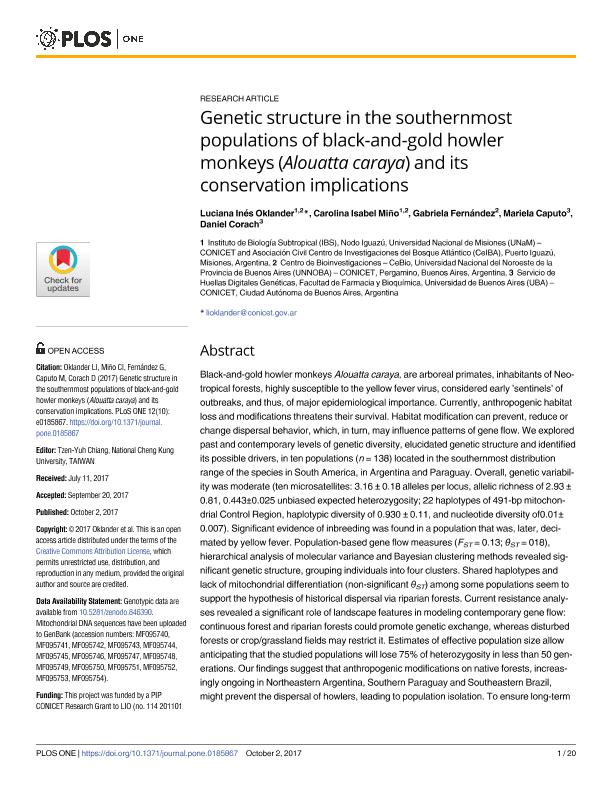Mostrar el registro sencillo del ítem
dc.contributor.author
Oklander, Luciana Inés

dc.contributor.author
Miño, Carolina Isabel

dc.contributor.author
Fernández, Gabriela
dc.contributor.author
Caputo, Mariela

dc.contributor.author
Corach, Daniel

dc.date.available
2018-04-25T18:42:56Z
dc.date.issued
2017-10
dc.identifier.citation
Oklander, Luciana Inés; Miño, Carolina Isabel; Fernández, Gabriela; Caputo, Mariela; Corach, Daniel; Genetic structure in the southernmost populations of black-and-gold howler monkeys (Alouatta caraya) and its conservation implications; Public Library of Science; Plos One; 12; 10; 10-2017; 1-20; e0185867
dc.identifier.issn
1932-6203
dc.identifier.uri
http://hdl.handle.net/11336/43479
dc.description.abstract
Black-and-gold howler monkeys Alouatta caraya, are arboreal primates, inhabitants of Neotropical forests, highly susceptible to the yellow fever virus, considered early ´sentinels´ of outbreaks, and thus, of major epidemiological importance. Currently, anthropogenic habitat loss and modifications threatens their survival. Habitat modification can prevent, reduce or change dispersal behavior, which, in turn, may influence patterns of gene flow. We explored past and contemporary levels of genetic diversity, elucidated genetic structure and identified its possible drivers, in ten populations (n = 138) located in the southernmost distribution range of the species in South America, in Argentina and Paraguay. Overall, genetic variability was moderate (ten microsatellites: 3.16 ± 0.18 alleles per locus, allelic richness of 2.93 ± 0.81, 0.443±0.025 unbiased expected heterozygosity; 22 haplotypes of 491-bp mitochondrial Control Region, haplotypic diversity of 0.930 ± 0.11, and nucleotide diversity of0.01± 0.007). Significant evidence of inbreeding was found in a population that was, later, decimated by yellow fever. Population-based gene flow measures (FST = 0.13; θST = 018), hierarchical analysis of molecular variance and Bayesian clustering methods revealed significant genetic structure, grouping individuals into four clusters. Shared haplotypes and lack of mitochondrial differentiation (non-significant θST) among some populations seem to support the hypothesis of historical dispersal via riparian forests. Current resistance analyses revealed a significant role of landscape features in modeling contemporary gene flow: continuous forest and riparian forests could promote genetic exchange, whereas disturbed forests or crop/grassland fields may restrict it. Estimates of effective population size allow anticipating that the studied populations will lose 75% of heterozygosity in less than 50 generations. Our findings suggest that anthropogenic modifications on native forests, increasingly ongoing in Northeastern Argentina, Southern Paraguay and Southeastern Brazil, might prevent the dispersal of howlers, leading to population isolation. To ensure long-term viability and maintain genetic connectivity of A. caraya remnant populations, we recommend preserving and restoring habitat continuity. To conserve the species genetic pool, as well, the four genetic clusters identified here should be considered separate Management Units and given high conservation priority. In light of our findings and considering complementary non-genetic information, we suggest upgrading the international conservation status of A. caraya to ?Vulnerable?.
dc.format
application/pdf
dc.language.iso
eng
dc.publisher
Public Library of Science

dc.rights
info:eu-repo/semantics/openAccess
dc.rights.uri
https://creativecommons.org/licenses/by/2.5/ar/
dc.subject
Genetic Differentiation
dc.subject
Monos Aulladores
dc.subject
Molecular Markers
dc.subject
Primates
dc.subject.classification
Otras Ciencias Biológicas

dc.subject.classification
Ciencias Biológicas

dc.subject.classification
CIENCIAS NATURALES Y EXACTAS

dc.title
Genetic structure in the southernmost populations of black-and-gold howler monkeys (Alouatta caraya) and its conservation implications
dc.type
info:eu-repo/semantics/article
dc.type
info:ar-repo/semantics/artículo
dc.type
info:eu-repo/semantics/publishedVersion
dc.date.updated
2018-04-18T15:10:55Z
dc.journal.volume
12
dc.journal.number
10
dc.journal.pagination
1-20; e0185867
dc.journal.pais
Estados Unidos

dc.journal.ciudad
San Francisco
dc.description.fil
Fil: Oklander, Luciana Inés. Universidad Nacional del Noroeste de la Provincia de Buenos Aires. Centro de Bioinvestigaciones (Sede Pergamino); Argentina. Consejo Nacional de Investigaciones Científicas y Técnicas. Centro Científico Tecnológico Conicet - Nordeste. Instituto de Biología Subtropical. Instituto de Biología Subtropical - Nodo Puerto Iguazú | Universidad Nacional de Misiones. Instituto de Biología Subtropical. Instituto de Biología Subtropical - Nodo Puerto Iguazú; Argentina
dc.description.fil
Fil: Miño, Carolina Isabel. Universidad Nacional del Noroeste de la Provincia de Buenos Aires. Centro de Bioinvestigaciones (Sede Pergamino); Argentina. Consejo Nacional de Investigaciones Científicas y Técnicas. Centro Científico Tecnológico Conicet - Nordeste. Instituto de Biología Subtropical. Instituto de Biología Subtropical - Nodo Puerto Iguazú | Universidad Nacional de Misiones. Instituto de Biología Subtropical. Instituto de Biología Subtropical - Nodo Puerto Iguazú; Argentina
dc.description.fil
Fil: Fernández, Gabriela. Universidad Nacional del Noroeste de la Provincia de Buenos Aires. Centro de Bioinvestigaciones (Sede Pergamino); Argentina. Consejo Nacional de Investigaciones Científicas y Técnicas; Argentina
dc.description.fil
Fil: Caputo, Mariela. Universidad de Buenos Aires. Facultad de Farmacia y Bioquímica. Servicio de Huellas Digitales Genéticas; Argentina. Consejo Nacional de Investigaciones Científicas y Técnicas; Argentina
dc.description.fil
Fil: Corach, Daniel. Consejo Nacional de Investigaciones Científicas y Técnicas; Argentina. Universidad de Buenos Aires. Facultad de Farmacia y Bioquímica. Servicio de Huellas Digitales Genéticas; Argentina
dc.journal.title
Plos One

dc.relation.alternativeid
info:eu-repo/semantics/altIdentifier/url/http://journals.plos.org/plosone/article?id=10.1371/journal.pone.0185867
dc.relation.alternativeid
info:eu-repo/semantics/altIdentifier/doi/http://dx.doi.org/10.1371/journal.pone.0185867
Archivos asociados
